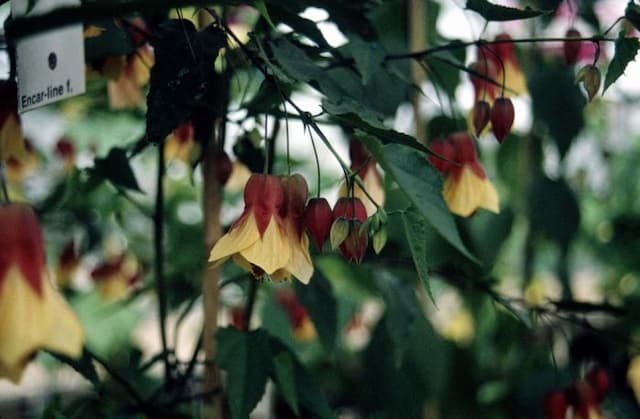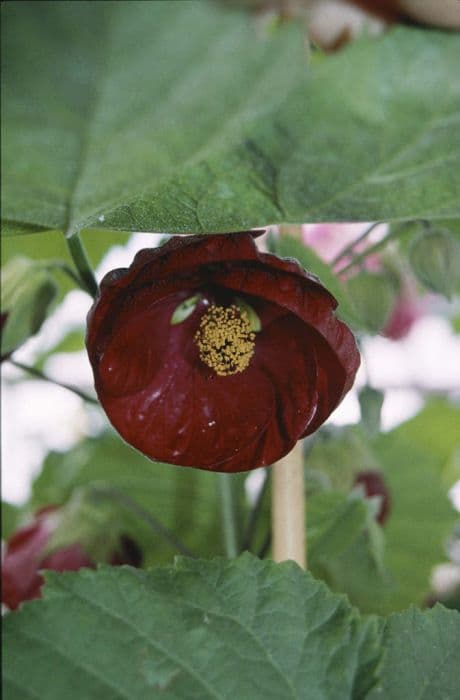Rose Mallow Lavatera trimestris 'Silver Cup'

ABOUT
Lavatera trimestris 'Silver Cup', commonly known as the Silver Cup mallow, boasts a striking appearance characterized by vibrant blooms and lush foliage. The flowers, which are the most eye-catching feature of the plant, present a showy display with their large, cup-shaped form. They are particularly noted for their rich color palette, typically found in shades of pink that can range from soft pastel to a deep rosy hue. Each bloom is accented with darker veins that radiate from the center, adding depth and texture to the overall visual effect. Surrounding these bold flowers, the foliage of the Silver Cup mallow is no less impressive. The leaves are a deep green color, with a slightly lobed or heart-shaped appearance that provides a lush, verdant backdrop for the flowers. The texture of the leaves is smooth with a gentle softness to the touch. In summary, the Silver Cup mallow is a floriferous plant known for its spectacular pink flowers and contrasting green foliage, creating a delightful display for any garden or landscape where it is showcased.
About this plant
 Names
NamesSynonyms
Annual Mallow, Rose Mallow, Silver Cup Lavatera, Royal Mallow
Common names
Althaea trimestris, Lavatera mauritiana, Malva trimestris, Malva mauritiana, M. malaca, M. mauritiana.
 Toxicity
ToxicityTo humans
The common name of Lavatera trimestris 'Silver Cup' is Rose Mallow. There is no widespread documentation of toxicity to humans for Rose Mallow. However, as with any plant, individual sensitivities can vary, and it is generally not advisable to ingest parts of ornamental plants due to the potential for stomach irritation or allergic reactions.
To pets
Rose Mallow is not listed as toxic to pets by major animal poison control resources. However, ingestion of plant material can cause gastrointestinal upset in some animals, leading to symptoms such as vomiting or diarrhea. It is always prudent to prevent pets from eating ornamental plants as even non-toxic plants might cause mild stomach upset.
 Characteristics
CharacteristicsLife cycle
Annuals
Foliage type
Deciduous
Color of leaves
Green
Flower color
Pink
Height
3 feet (0.91 meters)
Spread
1 foot (0.3 meters)
Plant type
Herb
Hardiness zones
7
Native area
Mediterranean
Benefits
 General Benefits
General Benefits- Ornamental Value: The Lavatera trimestris 'Silver Cup', commonly known as annual mallow, has large, showy flowers which enhance the visual appeal of gardens.
- Easy to Grow: Annual mallow is known for being an easy-to-grow plant, making it suitable for gardeners of all skill levels.
- Attracts Pollinators: The bright blooms attract bees, butterflies, and other beneficial pollinators, supporting local ecosystems.
- Rapid Growth: Annual mallow grows quickly, providing fast coverage and gratification in garden spaces.
- Drought Tolerance: This plant has a certain degree of drought tolerance once established, reducing the need for frequent watering.
- Versatility: Suitable for borders, beds, and as a background plant, the annual mallow is versatile in landscaping designs.
 Medical Properties
Medical PropertiesThis plant is not used for medical purposes.
 Air-purifying Qualities
Air-purifying QualitiesThis plant is not specifically known for air purifying qualities.
 Other Uses
Other Uses- Lavatera trimestris 'Silver Cup', commonly known as the annual mallow, can be used in natural dye production. The flowers and leaves contain pigments that can dye fabrics in shades of pink or green.
- The fibrous stems of the annual mallow can be used in the manufacturing of paper, providing an alternative to traditional wood pulp.
- The nectar-rich flowers of the annual mallow can be a valuable food source for both domestic and wild bees, contributing to the support of pollinator populations.
- Annual mallow can be planted as a cover crop in agriculture to suppress weeds, prevent soil erosion, and improve soil health between regular crop cycles.
- Due to its rapid growth and showy flowers, the annual mallow is suitable for use in educational projects to teach children about plant life cycles and gardening practices.
- Dried annual mallow flowers can be used in potpourri mixtures to add color and a subtle fragrance to indoor spaces.
- The stems and branches of the annual mallow can be used as a natural support material in the garden, providing a lattice structure for climbing plants.
- As a fast-growing ornamental, the annual mallow can be used in temporary garden displays or for event decoration, where temporary vibrant color is needed.
- Live or dried annual mallow flowers can serve as an artistic medium for floral art, pressed flower crafts, and botanical illustration.
- Annual mallow can be incorporated into wildlife gardens as a food source for caterpillars of certain moth species, fostering biodiversity.
Interesting Facts
 Feng Shui
Feng ShuiThe Lavatera is not used in Feng Shui practice.
 Zodiac Sign Compitability
Zodiac Sign CompitabilityThe Lavatera is not used in astrology practice.
 Plant Symbolism
Plant Symbolism- Delicate Femininity: Lavatera trimestris, commonly known as Rose Mallow, often symbolizes delicate and graceful femininity due to its soft, gentle, and often pink-colored flowers.
- Bountifulness: The prolific blossoms of the Rose Mallow can represent bountifulness and abundance.
- Breath of Life: With its open trumpet-shaped flowers, it can symbolize the breath of life or the offering of oneself to the world.
- Renewal: As an annual plant that blooms generously and can re-seed itself, the Rose Mallow can stand for renewal and the continuous cycle of life.
- Overflowing Love: The overflowing nature of its blooms can be seen as a representation of overflowing love or emotions.
- Survival and Resilience: Despite its delicate appearance, Lavatera trimestris can thrive in challenging conditions, symbolizing survival and resilience.
 Water
WaterThe Rose Mallow, or 'Silver Cup', requires consistent moisture, especially during the growing season. Watering should be done deeply and thoroughly to encourage strong root growth. The plant typically needs watering once a week, but this may need to be increased to twice a week during the warmer months or periods of drought. Ensure that each watering provides enough water to moisten the soil to a depth of at least 6 inches. This generally equates to about 1 to 1.5 gallons of water for each plant per week, although soil type and weather conditions can alter this requirement.
 Light
LightRose Mallow thrives best in full sunlight, where it receives direct light for at least 6 to 8 hours a day. The optimal spot for this plant is in an area that provides unfiltered, full sun exposure throughout the day. If grown indoors, it should be placed near a south-facing window to ensure adequate light.
 Temperature
TemperatureThe Rose Mallow prefers temperate conditions and does best in temperatures ranging from 60°F to 75°F. The plant can tolerate a minimum temperature of about 40°F, and a maximum temperature of approximately 85°F. However, prolonged exposure outside of the ideal temperature range can stress the plant and affect its growth and flowering.
 Pruning
PruningPruning Rose Mallow promotes healthy growth and encourages more blooms. Prune in the early spring to remove any dead or damaged growth and to shape the plant. Additionally, deadheading, or removing spent flowers, can be done throughout the blooming season to encourage more flowers to form. The best time for major pruning is in late winter or early spring, just before new growth begins.
 Cleaning
CleaningAs needed
 Soil
SoilThe Rose Mallow 'Silver Cup' thrives best in a well-draining, fertile soil mix with a pH between 6.0 and 7.0. A mix of loam, compost, and sand or perlite is ideal to ensure good drainage and fertility. Mulching helps retain moisture and keeps roots cool.
 Repotting
RepottingRose Mallow 'Silver Cup' doesn't typically require frequent repotting as it is often grown as an annual. However, if grown as a perennial, repotting every 2 to 3 years or when root-bound can promote healthy growth.
 Humidity & Misting
Humidity & MistingRose Mallow 'Silver Cup' prefers moderate humidity levels but is quite tolerant and can thrive in average home humidity conditions without the need for additional humidity adjustments.
 Suitable locations
Suitable locationsIndoor
Ensure bright light, well-draining soil, and room to grow.
Outdoor
Full sun, well-drained soil, water when dry, protect from frost.
Hardiness zone
7-9 USDA
 Life cycle
Life cycleLavatera trimestris 'Silver Cup', also known as Rose Mallow 'Silver Cup', begins its life cycle when seeds are sown in well-draining soil after the danger of frost has passed. The seeds germinate, typically within two to three weeks, and seedlings soon emerge with their first true leaves. As the plant grows, it develops a bushy form with deeply lobed leaves and begins to produce its distinctive, showy flowers, often starting in late spring or early summer. These bowl-shaped flowers continue to bloom throughout summer and may persist into early autumn, attracting bees, butterflies, and other pollinators. After pollination, the flowers produce seeds that mature, allowing for self-sowing if they are not collected. As the weather cools and day length shortens, Rose Mallow 'Silver Cup' completes its annual cycle, withering with the first hard frost, but potentially leaving behind seeds to start the next generation.
 Propogation
PropogationPropogation time
Spring-Early Summer
Propogation: For the plant known commonly as the Rose Mallow 'Silver Cup', the most popular method of propagation is by sowing seeds. The ideal time to start seed propagation is in spring after the danger of frost has passed. Sow the seeds directly into the ground at a depth of about 1/4 inch (approximately 6 millimeters) or scatter them on the soil surface and gently press them into the earth. Rose Mallow 'Silver Cup' prefers well-drained soil and full sun to part shade for optimal growth. Water the seeds gently and keep the soil moist but not waterlogged to encourage germination. Seeds generally take one to two weeks to germinate, and once the seedlings have grown large enough to handle, they should be thinned out to allow ample space for the mature plants to develop.









